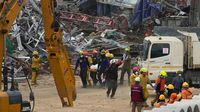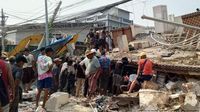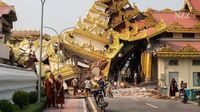The earthquake that struck Myanmar on March 28, 2025, has left a devastating mark on the country, with the death toll rising to at least 1,700 and expectations that it could climb even higher as rescue efforts reach remote areas. This tragedy unfolded as the nation grapples with the ongoing impacts of a civil war that has intensified since the military coup in 2021.
With a magnitude of 7.7 on the Richter scale, the earthquake's epicenter was located near Sagaing, just outside the major city of Mandalay, which is home to approximately 1.6 million residents. Images emerging from Mandalay depict streets where nearly every other house has either collapsed or suffered significant damage. The United Nations estimates that prior to the earthquake, around 20 million people in Myanmar were already reliant on humanitarian aid, highlighting the dire situation that has only worsened following the quake.
As of now, the military government has confirmed that 1,700 individuals have perished, with an additional 3,400 reported injured. The U.S. Geological Survey (USGS) has warned that the death toll could potentially reach 10,000, with economic damages expected to exceed Myanmar's annual income. In a tragic comparison, the earthquake's magnitude was similar to that of the 2023 Turkey earthquake, which caused catastrophic destruction.
Reports indicate that the tremors were felt as far away as Bangkok, Thailand, where a construction site collapsed, resulting in at least 17 fatalities and 76 individuals still unaccounted for. In Myanmar, the destruction has been extensive, with countless homes, hospitals, fire stations, and health centers obliterated. The airports in Mandalay and the new capital, Naypyidaw, are currently inoperative, and many bridges and roads have become impassable.
Despite the overwhelming need for assistance, the military junta, led by General Min Aung Hlaing, has continued its air strikes against rebel forces, even as the nation copes with the aftermath of the earthquake. Reports from the region indicate that airstrikes in northern Shan province have resulted in further casualties, with seven people killed in Naungcho. This has drawn condemnation from the United Nations, which labeled the attacks as "completely outrageous and unacceptable" given the circumstances.
In a surprising move, the military government has publicly appealed for international aid, a notable shift for a regime that has largely isolated Myanmar since the coup. Neighboring countries such as India, China, and Thailand have already pledged or dispatched relief supplies. The Indian army has set up a field hospital for victims, while the European Union is providing satellite imagery from its Copernicus Earth observation program to assist in the relief efforts.
The National Unity Government (NUG), a shadow government formed by elected representatives opposing the junta, has declared a 14-day unilateral ceasefire to facilitate humanitarian assistance. They have stated that they will conduct relief operations alongside resistance fighters and civil society groups. However, there are concerns about the junta's commitment to genuinely facilitating aid, as many survivors report a lack of state assistance and resources.
Survivors have fled the devastated areas, with hotels in the suburbs of Mandalay opening their doors to those seeking refuge. Many have arrived with nothing but the clothes on their backs, traumatized by the experience. An anonymous source described the panic and despair among those who have fled, stating, "Today there was an aftershock. The people here are traumatized, all panicked and crying. Mentally and physically, these people are at their limit." The source added that there has been no visible presence of emergency services, with survivors digging through rubble with their bare hands in search of those still trapped.
Kamlesh Vyas, an aid worker with the Swiss organization Helvetas, remarked on the dire conditions, noting that many individuals remain buried under debris. "Survivors are lacking medical care, and drinking water is becoming scarce," he stated. Communication with local staff has been challenging due to power outages and internet disruptions, complicating relief efforts.
International offers of assistance, including from Taiwan, have been made but remain unaccepted by the junta, likely due to concerns over upsetting their ally, China. This reluctance to accept help raises fears that the affected population may become pawns in the political maneuvering of the military government.
In the wake of the earthquake, significant cultural landmarks have also suffered damage. Notably, the Mahamuni Buddha Pagoda in Mandalay, the second most important shrine in Myanmar, was severely impacted. The spiritual implications of this disaster resonate deeply in a country where many believe in collective karma, where the suffering of the populace is seen as a reflection of their past actions.
As Myanmar faces this dual crisis of natural disaster and ongoing civil conflict, the future remains uncertain. The historical parallels drawn between the current situation and a devastating earthquake in 1930, which was perceived as a sign of impending political change, offer a glimmer of hope for some. Nyein Win, a resident of Yangon, believes that the earthquake could signal the end of the junta's reign, stating, "This is a clear sign that the end of the junta is near."
As the nation grapples with the aftermath of this catastrophe, the need for unity and cooperation among all factions becomes ever more critical. The path to recovery will undoubtedly be fraught with challenges, but the resilience of the people of Myanmar shines through in their determination to support one another in these trying times.






